the 8th, 10th, and 11th Congressional Districts are in Northern Virginia, but the 9th District has been in southwestern Virginia for over a century
Source: US Geological Survey, Congressional Districts - 113th Congress

|
In 2014, there are 12 races for Federal office.
Virginians will elect 11 members to the House of Representatives, plus one member to the US Senate. There are three candidates for the Senate seat, including the Libertarian candidate. Libertarian, Green, Independent Green, and Independent candidates are also running for the House of Representatives seats in Northern Virginia (Districts 1, 8, 10, and 11 - and District 7, if you consider Spotsylvania County to be in "Northern" Virginia). There are also some local elections in 2014. In Manassas, four candidates are competing for three seats on City Council. The Republican Party, which has controlled Manassas government for decades, nominated only two candidates - so for the first time in memory, a Democrat will serve on the Manassas City Council. However, the partisan divide that is so clear at the national level is often blurred in local government. Zoning and land use issues divide members of town councils, city councils, and boards of county supervisors, but the splits often reflect different priorities for managing growth and economic development rather than "red vs. blue" differences. A standard comment at the local level is that fixing potholes is not partisan... Only 5 political offices in Virginia are determined by statewide election. There are 2 US Senate seats, plus three state offices - Governor, Lieutenant Governor, and Attorney General. All other officials elected in Virginia represent just a portion of the entire state. In 2015, elections will be for just the Virginia General Assembly (House of Delegates and State Senate) and local offices. None of the 13 officials elected to the US Congress (11 to the House of Representatives, 2 to the US Senate) will be on the ballot. The presidential election will still be a year away, in 2016. Even without a map, some simple math will reveal that State Senate districts are larger than House of Delegates districts. All 8,001,024 Virginians counted in the 2010 Census are represented by a State Senator and by a Delegate. Divide 8,001,024 by 100, and you will define the ideal number of people to be represented by a Delegate. Divide by 40 for State Senators, and clearly each State Senator is representing more people and a larger area of Virginia. Boundaries of election districts are re-drawn after every Census. The process takes time, but the General assembly adopted a new map for elections in time for the 2012 elections. In 2014, a Federal court ruled that the boundary of the 3rd District for US House of Representatives had to be revised, because the district was designed based on race. That revision, if it occurs, is likely to move more Democratic-leaning voters into the 4th District, potentially affecting the 2016 campaign of Rep. Randy Forbes in the 4th District. |

There are more election campaigns for local offices than for state/Federal offices. Virginia has about 3,100 elected officials in the state. Only 143 officials are elected to state office, and only 13 members are elected from Virginia to the US Congress.1
Government by "town meeting," where all voters appear at just one event to make decisions in a public vote, is limited to homeowner associations and other small groups in Virginia - and political caucuses, where Republicans or Democrats gather to nominate their candidates.
In advance of an election, nominees are chosen by political parties through primary elections (where citizens go to polling places across the state and vote to select nominees) or caucuses (where party officials congregate at one location and vote for nominees).
Candidates qualify to get on the ballot by obtaining a minimum number of signatures on a petition. To get on the ballot for president, a candidate must get 10,000 valid signatures from registered voters - including at least 400 from each of the 11 congressional districts.
|
Failure to follow the rules can force candidates to wage a write-in campaign, which is not a viable strategy except in very small communities. In 2012, Governor Perry of Texas was kept off the Republican primary ballot in Virginia because his campaign failed to get the necessary signatures. In the General Election on November 6, 2012, voters could choose from five candidates representing the Republican Party, Democratic Party, Constitutional Party, Libertarian Party, and Green Party.
Conventional wisdom is that primaries attract independent voters with a middle-of-the-road perspective, while caucuses are dominated by more-liberal Democrats or more-conservative Republicans. In 2013, the Republican Party dropped plans to hold a primary election to a caucus. The change caused the Lieutenant Governor of Virginia, Bill Bolling, to drop out of the race for governor and the Attorney General, Ken Cuccinelli, won the nomination by default. In 2012, all 11 incumbent members of the House of Representatives (8 Republicans, 3 Democrats) won re-election. In 2014, there is one "open" seat for the US Congress. The incumbent in the 10th District (Frank Wolf) chose to retire, after winning election every two years since 1980. The incumbent US Representatives in the other 10 districts chose to run for another 2-year term, and the incumbent US Senator (Mark Warner) chose to run for a second 6-year term. The race for a US Senate seat in 2012 involved an "open" seat, since Senator Jim Web retired rather than seek a second six-year term. The contest to replace him featured two former governors of Virginia. Tim Kaine (Democrat) had served as governor between 2006-2010, while George Allen (Republican) served 1994-98. Kaine won the 2012 contest, making him the "junior" Senator from Virginia. He will become the "senior" Senator only after Sen. Mark Warner leaves office. The state legislature in Virginia is called the General Assembly. The state legislature's House of Delegates is equivalent to the US Congress's House of Representatives. In 2013, voters elected all 100 members in the House of Delegates, who serve 2-year terms. The 40 State Senators in the General Assembly serve 4-year terms, so in 2015 the voters will choose 100 delegates and 40 state senators. |
In 2014, the state senator from the 38th District resigned. A special election was held to fill the position, and the voters chose a Republican to replace the Democrat who had resigned. That election changed the balance of power in the State Senate. It had been 20 Republicans and 20 Democrats, so Lieutenant Governor Ralph Northam broke most tie votes. He is a Democrat, but after the election in the 38th District the Republicans had a 21-19 majority and could block the #1 priority of Democratic Gov. Terry McAuliffe to expand "Obamacare" in Virginia.
Virginia does not officially record the political allegiance of voters when they register. You may claim to be a "registered Republican" or "official Democrat" or "card-carrying Libertarian/Green/Independent Green," but those labels come from recognition by political parties or other organizations and not the state of Virginia. Unlike some states, in Virginia the State Board of Elections and the local Electoral Boards do not maintain lists of voters by political affiliation.
However, the lists of people who voted in elections are made public. Who you vote for is a secret - but the fact that you registered is public. If you voted, that fact is also public. Who you voted for... only that decision remains private.
If you vote in a last Republican/Democratic primary, then expect to receive literature and phone calls about future elections from Republican/Democratic candidates. If you participate in a caucus, then you have to identify yourself and promise to vote for that party's nominees. Your participation in a caucus will reveal your political preference for that one nomination decision, but your actual vote in the General Election will be a secret You can break your promise, and no one will ever know.
Where you vote is determined by where you live, not where you work. When people move, in Virginia they must change their voter registration in order to vote.
Some counties and cities elect some or all of their local politicians "at-large." When voters enter the polling booth in such areas, they can vote for more than one candidate. The top vote-getters in the entire county/city are elected, regardless of the geographic split of the vote within the county/city. The at-large process resembles the way 5 officials (two US Senators and the Governor, Lieutenant Governor, and Attorney General) are elected in statewide votes.
Other counties and cities in Virginia have defined magisterial districts or wards from which individual county Board of Supervisors or the City Council members are elected. In such counties and cities, voters can choose only one candidate for their particular district. Such local elections are comparable to the elections for the General Assembly.
There are also hybrid systems. In Fairfax County, the Board of County Supervisors consists on nine members elected from different magisterial districts plus a tenth member elected from all voters in the county as the Chair.
In Prince William County, there are eight members on the Board of County Supervisors. Seven are elected from separate magisterial districts, while one is elected county-wide as the Chair.
Voters across the entire county can vote for the Chair of the Board of Supervisors, and also vote for the supervisor in one magisterial district. The county is divided into seven districts, with the chair being the eighth member of the Board of County Supervisors. Candidates for the county-wide seat of Chair seek support from all voting-age residents across the county. In contrast, candidates for each district restrict their campaigning to less than 20% of the county's population - the ones eligible to vote in their particular magisterial district.
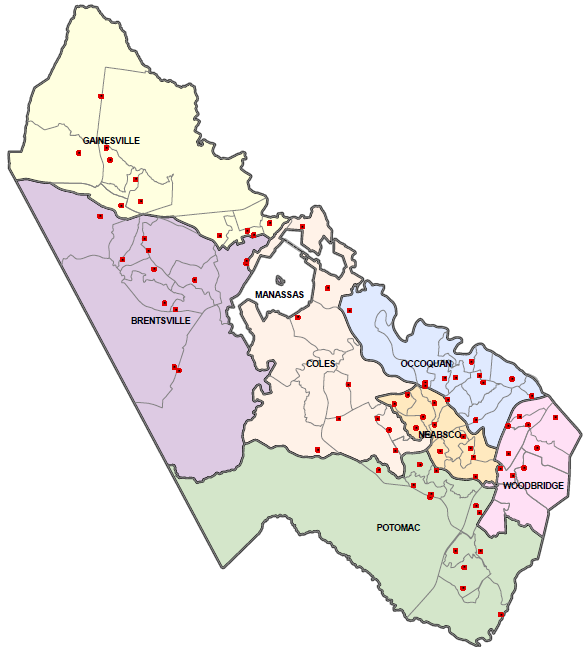
|
The top 5 state officials (two US Senators, Governor, Lieutenant Governor, and Attorney General) are elected "at large," by a majority vote of everyone in the state who chooses to vote. Electing officials "at large" rather than through wards/districts may discourage election of candidates representing minority views, or minority races and ethnic groups within a county/city. For example, the City of Manassas has no wards/districts and 51% of the voters can elect 100% of the officials.
Roanoke debated replacing its at-large elections in 1998, but rejected a proposal to divide the city into 5 wards. The proponents of a ward system suggested electing representatives from separate wards would empower residents from separate neighborhoods, including the poor section of town perceived as under-represented by the current system of city-wide elections. Others pointed to the city's election of a black mayor (Noel Taylor) in 1976 as evidence that a ward system was not needed. In Richmond, the Federal government forced the city to establish wards, to help ensure the City Council's racial profile reflects the city's racial profile. In the 1960's, when black residents were nearing a majority of the city residents, there were only one or two blacks elected to the 9-member City Council. Richmond was a highly-segregated city, with the black population concentrated in the neighborhoods east of the Boulevard. Social issues that were priorities for black residents in the city's East End, including public safety, were not adequately addressed while the City Council focused on issues of concern to the business leaders on Main Street. After passage of the Voting Rights Act of 1965, the Federal government forced Richmond to adopt a ward system. The number of elected officials from the eastern side of town was perceived as insufficient, and the system of electing the top 9 candidates citywide was considered discriminatory. Once the ward system was established after the 1970 census, the majority of individuals elected to City Council were black - reflecting more accurately the racial profile of the city population. |
Many political issues in the capital city are still racially-based, but the power of black and white residents has reversed. With a ward system, now it is the white residents living in the West End who rely upon their local City Council member to ensure their concerns will receive more than token representation.
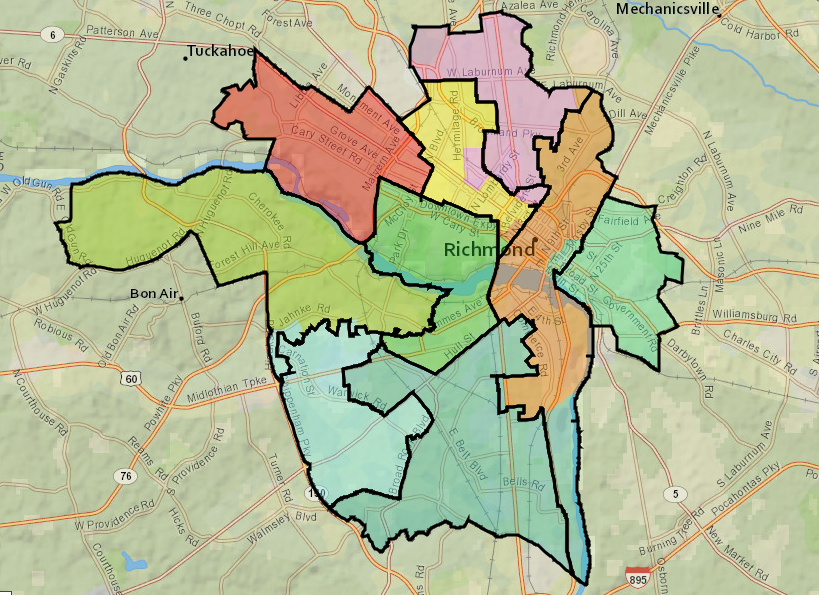
At the state level, the Virginia legislature is called the General Assembly. It is the oldest elected representative body in the United States in continuous operation. It started in 1619 as a political unit of the Virginia colony, and became the legislative body of the independent state of Virginia in 1776 - 12 years before the Federal Congress was first elected in 1788, after ratification of the Constitution.
|
There are 40 members in the State Senate, and 100 members in the House of Delegates, for a total of 140 members of the General Assembly. Every 2 years we elect the 100 Delegates to the House, and every 4 years we elect 40 State Senators. Elections to the General Assembly are held in odd-numbered years such as 2013 and 2015, while elections to the US Congress (the Federal legislature) occur in even-numbered years such as 2014 and 2016.
Virginians voted for 100 members of the House of Delegates (half of the General Assembly) and the 40 seats in the State Senate (the other half of the state legislature) in November 2011. State Senators serve 4-year terms, so the 40 State Senators elected in 2011 can serve until the next scheduled election on November 3, 2015. Virginia is the only state that has a 1-term limit for governor. Current Governor Bob McDonnell was prohibited from succeeding himself, so he could not run for re-election in 2013. His political career appears to have ended, after he became the first Virginia governor ever convicted of corruption in September 2014. Virginia's one-term limit applies to serving consecutive terms. Mills Godwin was elected governor twice, in 1965 and again in 1973. Godwin had to sit out for four years after his first term ended in 1969, and during that hiatus he switched from the Democratic to the Republican party. For a long time between the 1950's and 1970's, the Byrd Machine supported the "election every year" cycle. Elections in odd-numbered years allowed the Byrd Machine to advocate for conservative Democratic candidates for state and local offices, while allowing support of conservative Republican candidates for President every 4 years. That political balance fell apart in 1973 - the year of "Armageddon," according to a book of that name by Virginia election scholar Larry Sabato - but Virginia still has an election cycle that is out of synch with national campaigns. |
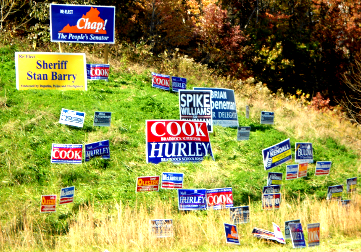 November 2011 campaign signs on Braddock Road, west of Fairfax campus |
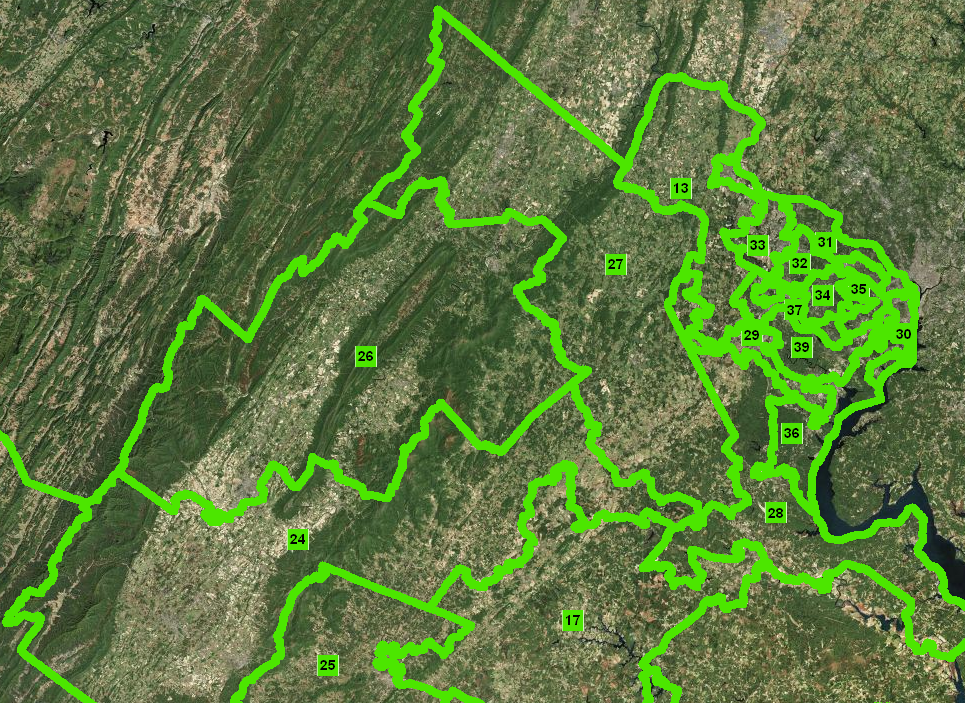
In the 2011 election, the Republicans won control of the State Senate. Before that election, the Republicans controlled the House of Delegates but Democrats controlled the State Senate by a majority of 22-18.
The Republicans won a net of two Senate seats in 2011, allowing the Lieutenant Governor (a Republican) to break tie votes. The Lieutenant Governor decided the state constitution blocked him from breaking ties on the votes to approve the budget, so the budget in 2012 was delayed. Finally, one Democrat (State Senator Charles Colgan from Prince William County) voted to approve the budget, and it passed 21-19.
Despite the significance of the 2011 election, in which control of the State Senate hung on a switch of just 2 seats, only 15 of the 40 contests for State Senate had only one major party candidate on the ticket. Only 27% of the major party House of Delegates races included contests between Republicans and Democrats, and in many of those contested elections one of the Republican/Democratic candidates had "no experience, no money, no campaign organization and no hope of victory."2
Redistricting has allowed incumbents to shape districts that ensure re-election, consolidating Republican-supporting voters in some districts and overloading other districts with Democrats to create "safe seats." Thanks to the power of Geographic Information System (GIS) technology, politicians now choose their voters when election districts are revised after every Census.
Prior to the Baker v. Carr US Supreme Court decision in 1962 that voting districts had to have approximately the same number of people, the political machine of Harry Byrd had structured Virginia districts so urban areas were under-represented and Byrd's rural supporters elected an excessive number of General Assembly members. Once the urban areas received full representation, the General Assembly politics changed - and after 1965 Virginia voters approved borrowing money for roads, building a community college system, and selling liquor-by-the-drink in public restaurants.
Governor and then Senator Harry Byrd built an "organization" that stayed in power for nearly 50 years by helping the rural areas at the expense of the urban areas. Byrd then extended control a few more years by manipulating racial tensions. The Massive Resistance effort to block Federal mandates for desegregating schools was defeated by Virginians who wanted their children to get an education - but not before schools in for localities were closed for a semester. In Prince Edward County, the local county government kept the public schools closed for four years, in hopes of perpetuating the separate-but-equal system - even after Federal courts had determined "separate" was far from "equal."
Ethnic and racial biases still affect Virginia's politics, but Virginia's population is too diverse, and too concentrated in urban/suburban areas, for a rural-based "organization" to dominate the state again. The swing vote that determines the winner in statewide elections is now concentrated in areas with a blend of urban and rural characteristics - the suburbs, places such as Loudoun, Prince William, Stafford, Chesterfield, Chesapeake, Gloucester, and York counties.
1. Table 2, "Elected Officials of State and Local Governments by State: Census Years 1977 to 1992" in Popularly Elected Officials, Bureau of Census, GC92(1)-2, June 1995, http://www.census.gov/prod/2/gov/gc/gc92_1_2.pdf (last checked October 29, 2012)
2. "Two-party system on the ropes in Virginia races," Washington Post editorial, October 25, 2011, http://www.washingtonpost.com/opinions/two-party-system-on-the-ropes-in-virginia-races/2011/10/24/gIQA7wJ6GM_story.html (last checked October 29, 2012)
